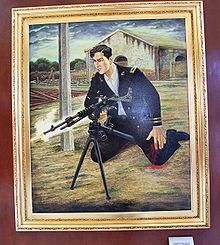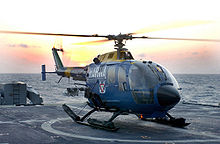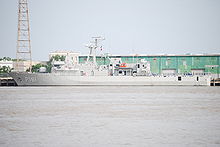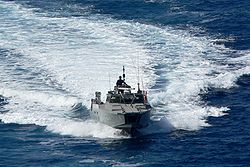- Mexican Navy
-
Mexican Navy
(Armada de México)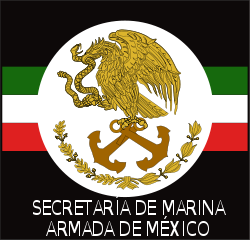
Mexican Navy EmblemActive January 19, 1821 Country United Mexican States Type Navy Size 56,000 personnel Part of Secretary of The Navy Anniversaries November 23.[1] Engagements Mexican Revolution Mexican-American War
World War II,
Commanders Current
commanderAdmiral Mariano Francisco Saynez Mendoza Insignia Naval Jack 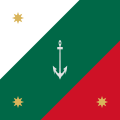
The Mexican Navy (Armada de México or SEMAR) is the naval branch of the Mexican military responsible for conducting naval operations. Its stated mission is "to use the naval force of the federation for the exterior defense, and to help with internal order".[2] The Navy consists of about 56,000 men and women plus reserves,[3] over 189 ships, and about 130 aircraft.[4][5] The Navy maintains a constant modernization program in order to upgrade its response capability, although its programs are hindered by a lack of funding due to variable budgets and lack of continuity.
Given Mexico's large area of water (3,149,920 km2) and extensive coastline (11,122 km), the navy's duties are of great importance. Perhaps its most important on-going missions are the war on drugs and protecting PEMEX's oil wells in Campeche in the Gulf of Mexico. Another important task of the Mexican Navy is to help people in hurricane relief operations and other natural disasters.
Contents
History of the Armada
Azueta's defense of Veracruz
The Mexican Navy has its origins in the creation of the Ministry of War in 1821. From that year until 1939 it existed jointly with the Army in the organic ministry. Since its declaration of independence from Spain in September 1810, through the mid decades of the 19th century, Mexico found itself in a constant state of war, mostly against Spain which had not recognized its independence. Therefore its priority was to purchase its first fleet from the U.S.A. in order to displace the last remaining Spanish forces from its coasts.[6]
The Mexican Navy has participated in many naval battles to protect and defend Mexico's interests. Some of the most important battles were:
- Attempts by Spain to reconquer Mexico
- Takeover of the San Juan de Ulúa fort (1821–1825)
- The invasion of Cabo Rojo (1829)
- Battle of Mariel
The first French intervention in Mexico (The 'Pastry War') (November 1838 - March 1839)
- An entire Armada was captured at Veracruz
- Yucatán Independence (1841—1848)
- The Mexican–American War (1846–48)
- The Second French Intervention (1862–1867)
- The Mexican Revolution (1910–1919)
- First Battle of Topolobampo
- Second Battle of Topolobampo
- Third Battle of Topolobampo
- Action of 9 April 1914
- Fourth Battle of Topolobampo
Second invasion by the United States (April 9, 1914-November 23, 1914)
Historical ships
- Schooner Anáhuac
- Schooner Iguala
- Cutter Campechana
- Cutter Chalco
- Cutter Chapala
- Cutter Orizaba
- Cutter Texcoco
- Cutter Zumpango
- Cutter Papaloapan
- Cutter Tampico
- Cutter Tlaxcalteca
- Cutter Tuxpan
- Mexican Congress (previously called Navío Asia and San Jerónimo)
- Brigantine Constante
- Brigantine Vicente Guerrero
- Steamer Guadalupe
- Steamer Gunboat Libertad
- Steamer Gunboat Independencia
- Steamer Guerra Demócrata
- Gunboat Democráta
- Gunboat México
- Corvette Escuela Zaragoza
- Schoolship Escuela Yucatán
- Pontón Chetumal
- Gunboat Tampico
- Gunboat Veracruz
- Gunboat Nicolás Bravo
- Transport de Guerra Progreso
- Transport Vicente Guerrero
- Gunboat Agua Prieta
- Heavy Crusier Anáhuac
- Auxiliary Ship Zaragoza II
- School Ship Velero Cuauhtémoc
Organization
The President of Mexico is commander in chief of all military forces. Day-to-day control of the Navy lies with the Navy Secretary, currently Mariano Francisco Saynez Mendoza. The Navy has one General Headquarters, two naval forces, 7 regions, 13 zones, and 14 naval sectors.
The Navy is divided into three main forces:
- Fuerza Naval del Golfo y Mar Caribe (Gulf and Caribbean Sea Naval Force)
- Fuerza Naval del Pacífico (Pacific Naval Force)
- Fuerza Aeronaval (Naval Aviation)
Officers are trained at the Mexican Naval Academy, called the "Heroica Escuela Naval Militar" ("Heroic Military Naval School"), located in Antón Lizardo, Veracruz.
Training and Education
A BO-105 helicopter of the Mexican Navy
The Navy offers several options for graduate studies in their educational institutions:
It is the school where future officers are trained for the General Corps of the Navy. Candidates can enter upon completing high school. Upon completion of studies, graduates obtain the degree of Corbeta Lieutenant and the title of Naval Science Engineer.
- Naval Medical School
This school Located in Mexico City, offers a career in medicine. Officers are trained with skills for the prevention and health care of naval personnel. By adopting a professional examination, graduates can obtain the degree of Naval Military Lieutenant Corvette.
- Naval Engineering School
In the Naval Engineering School, officers are responsible for the preventive and corrective maintenance of systems and electronic equipment installed on ships and installations of the Mexican Navy. This school offers career of Electronic Engineering and Naval Communications. It is located between the town of Mata Grape and Anton Lizardo, 32 km from the port of Veracruz.
- Naval Nursing School
Here the time to achieve a nursing degree lasts eight semesters. Officers are trained with the knowledge and skills necessary to enable them to assist medical personnel in caring for patients in hospitals, sanatoriums, clinics, health sections on land, aboard ships and at The Naval Medical Center.
- Naval Aviation School
The Naval Aviation School trains pilots for the Mexican Navy as well as staff from the Federal Preventive Police and Naval personnel from various countries of Central America. This school is located on Veracruz.[7]
- Search, Rescue and Diving School
Located in Acapulco, members of The Navy are trained for marine search, rescue and diving. It also trains state police officers and firefighters.
Structure
Main article: Mexican Naval InfantryThe Mexican Naval Infantry Corps was reorganized in 2007-2009 into 30 Naval Infantry Battalions (Batallones de Infantería de Marina - BIM), a paratroop battalion, a battalion attached to the Presidential Guard Brigade, two Fast Reaction Forces with six battalions each, and three Special Forces groups.[8] The Naval Infantry are responsible for port security, protection of the ten-kilometer coastal fringe, and patrolling major waterways.
Search and Rescue units
Main article: Maritime Search and Rescue (Mexico)In 2008, the Mexican Navy created its new search and rescue system, allocated in strategic ports at Pacific and Gulf of Mexico ports, to provide assistance to any ships which are in jeopardy or at risk due to mechanical failure, weather conditions or life risk to the crew. To provide such support, the Navy has ordered Coast Guard Defender class ships (2 per station, and one 47-Foot Motor Lifeboat coastal guard ships). Other stations will be provided only with Defender class boats.[9]
Modernization and budget
The annual Navy's budget is in a 1 to 3 proportion of the national budget relative to the Army & Air Force. For the year 2007, the Army got three billion dollars budget, versus one billion dollars for the Navy. The Navy has a reputation for being a well-run and well-organized outfit. This reputation allows for a close relationship with the U.S. Navy, as evidenced by the procurement of numerous former USN ships.
Ships
 CB 90 HMN - Polaris class patrol interceptor
CB 90 HMN - Polaris class patrol interceptor
The Secretary of the Navy, Admiral Francisco Saynez Mendoza, announced on October 1, 2007, detailed plans to upgrade and modernize the country's naval capabilities. On the following day, La Jornada newspaper from Mexico City, disclosed the Mexican Navy plans, which are among others, to build six oceanic patrol vessels (OPV) with length of 86 meters, 1680 tons and each housing a Eurocopter Panther helicopter as well as small high speed interception boats. The budget for this project is above $200 million USD.
Another project is to build 12 CB 90 HMN high speed (50 knots) interception boats under license from a Swedish boat company to the Mexican Navy. Also, a number of fully equipped planes for surveillance and maritime patrol are being considered. Combinations of options and development are being defined.
Shipbuilding
Main article: Secretary of The Navy ShipyardsThe Mexican Navy depends upon their naval shipyards for construction and repairs of their ships. There are 5 shipyards located in the Gulf of Mexico and Pacific Ocean:
- Gulf of Mexico
- Naval shipyard 1 (ASTIMAR 1) - Tampico, Tamaulipas
- Naval shipyard 3 (ASTIMAR 3) - Coatzacoalcos, Veracruz
- Pacific Ocean
Missiles
The Mexican Navy initiated studies to develop and construct its first missile, according to a May 2005 interview with the undersecretary of the Navy, Armando Sanchez, the missile was to have an average range of 12 to 15 kilometers and be able to target enemy ships and aircraft. The undersecretary added that they already had the solid propellant, and the basic design of the missile. All aspects relative to their fuselage were solved as well as the launch platforms. The Mexican Navy was developing the computer software to direct the missile to its target. In July 2008, the project was reported to be 80% complete. Despite this effort, the missile development was canceled in 2009 due to "problems with the propulsion system".[10]
Radar modernization
In 2009, the Mexican Navy will begin operating a batch of new MPQ-64 Sentinel radars in the oil-rich Gulf of Mexico. The radar network was installed in 2007 for a trial phase while military personnel were trained to get familiar with the system. The new installations will work together with combat surface vessels that patrol the area.[11][12]
Present fleet
Main article: List of Mexican Navy shipsDestroyers
- Quetzalcoatl Class Ex US-Navy Gearing-FRAM II class.
- ARM Netzahualcoyotl (D-102) (1982) - present
- Manuel Azueta Class
- ARM Manuel Azueta (D-111) (1973) - present
Frigates
- Bravo Class
- ARM Bravo (F-201) (1993) - Present
- ARM Galeana (F-202) (1993) - Present
- Allende Class frigate All drydocked due to lack of funding from Narcowar.
- ARM Allende (F-211) (1997) - Present
- ARM Abasolo (F-212) (1997)- Present
- ARM Victoria (F-213) (2000) - Present
- ARM Mina (F-214) (2002) - Present
Amphibious ships
- Panuco Class
- ARM Rio Panuco (A-01)
- ARM Manzanillo (A-02) (1971) - present
- Papaloapan Class
- ARM Papaloapan (A-411) (2001) - Present
- ARM Usumacinta (A-412) (2001) - Present
- Montes Azules Class
- ARM Montes Azules BAL-01 (2011)
Missile boats
- Huracan Class Ex Israeli Navy Aliya class (Saar 4.5).
- ARM Huracan (A-301) (2004) - present
- ARM Tormenta (A-302) (2004) - present
Offshore patrol vessels
 Durango class corvettes
Durango class corvettes
- Valle class Ex US-Navy minesweepers. Bought in 1972 and 1973.
- ARM Juan de la Barrera (P102) - Active
- ARM Mariano Escobedo (P103) - Active
- ARM Manuel Doblado (P104) - Active
- ARM Santos Degollado (P106) - Active
- ARM Juan N. Álvarez (P108) - Active
- ARM Manuel Gutiérrez Zamora (P109) - Active
- ARM Valentín Gómez Farías (P110) - Active
- ARM Francisco Zarco (P112) - Active
- ARM Ignacio L. Vallarta (P113) - Active
- ARM Jesús González Ortega (P114) - Active
- ARM Mariano Matamoros (P117) - Active
- Uribe class. All the ships of this class were built by Spain in 1982. Similar to Serviola class used by Spanish Navy.
- ARM Uribe (PO-121) - Active
- ARM Azueta (PO-122) - Active
- ARM Baranda (PO-123) - Active
- ARM Breton (PO-124) - Active
- ARM Blanco (PO-125) - Active
- ARM Monasterio (PO-126) - Active
- Holzinger class. This ships were developed in Mexico based on the Uribe class.
- ARM Holzinger (PO-131) (1991) - Active
- ARM Godinez (PO-132) (1991) - Active
- ARM De La Vega (PO-133) (1994) - Active
- ARM Berriozabal (PO-134) (1994) - Active
- Sierra class corvettes. This class of ships was developed and built in Mexico.
- ARM Sierra (PO-141) (1999) - Active
- ARM Juarez (PO-142) (1999) - Out of Service [13]
- ARM Prieto (PO-143) (1999) - Active
- ARM Romero (PO-144) (1999) - Active
- Durango class. This class of ships was developed and built in Mexico.
- ARM Durango (PO-151) (2000) - Active
- ARM Sonora (PO-152) (2000) - Active
- ARM Guanajuato (PO-153) (2001) - Active
- ARM Veracruz (PO-154) (2001) - Active
- Oaxaca class. This class of ships was developed and built in Mexico.
- ARM Oaxaca (PO-161) (2003) - Active
- ARM Baja California (PO-162) (2003) - Active
- ARM Independencia (PO-163) (2010) - Active
- ARM Revolucion (PO-164) (2010) - Active on November 2010
Coastal patrol ships
- Azteca class
Designed and built by Vosper Thornycroft with updates by the Mexican Navy Shipyards.
- ARM Cordova (PC 202) (1974)
- ARM Rayón. (PC 206) (1975)
- ARM Rejón. (PC 207) (1975)
- ARM De la Fuente. (PC 208) (1975)
- ARM Guzmán. (PC 209) (1975)
- ARM Ramírez. (PC 210) (1975)
- ARM Mariscal. (PC 211) (1975)
- ARM Jara (PC 212) (1975)
- ARM Colima (PC 214) (1975)
- ARM Lizardi (PC 215) (1975)
- ARM Mugica (PC 216) (1976)
- ARM Velazco (PC 218) (1976)
- ARM Macías (PC 220) (1976)
- ARM Tamaulipas (PC 223) (1977)
- ARM Yucatán (PC 224) (1977)
- ARM Tabasco (PC 225) (1978)
- ARM Cochimie (PC 226) (1978)
- ARM Puebla (PC 228) (1982)
- ARM Vicario (PC 230) (1977)
- ARM Ortíz (PC 231) (1977)
- Demócrata class
- ARM Demócrata (PC 240)
- ARM Francisco I. Madero (PC 241)
- Cabo class
- ARM Cabo Corrientes
- ARM Cabo Corso
- ARM Cabo Catoche
- Punta class
- ARM Punta Morro
- ARM Punta Mastún
Cabo Corrientes class
- ARM Cabo Corrientes (PC-271)
- ARM Cabo Corso (PC-272)
- ARM Cabo Catoche (PC-273)
Other ships
The Mexican Navy includes 60 smaller patrol boats and 32 auxiliary ships. It acquired 40 fast military assault crafts, designated CB 90 HMN, between 1999 and 2001 and obtained a production license in 2002 allowing further units to be manufactured in Mexico.
For the year 2008 budget, the Mexican Congress approved a $15 million USD funds to build only 17 out of 60 combat boats requested. These ships, designated CB 90 HMN, are to increase its fast boat fleet. Additional budgets will be awarded each passing year.[14] In total, the Mexican Navy has over 189 operational ships.[4]
Equipment and vehicles
Mexican Naval Infantry Inventory Vehicle/System Status Origin Land vehicles Sherpa APC  European Union
European UnionBTR-60/BTR-70 Has diesel engine and it does not have the turret with the 14.5 mm machine gun. Used with a 40 mm grenade launcher  Russia
RussiaUral-4320 Off-road 6x6 truck  Russia
RussiaUNIMOG U-4000[15][16]  Germany
GermanyGama Goat Amphibious 6-wheeled vehicle. Used with a 40 mm Mk 19 grenade launcher or an Oerlikon 20 mm cannon.  United States
United StatesFreightliner M2[17] 4x2 truck  Mexico
MexicoFord-150[18] 4x4 F-150 series pick up  United States
United StatesFord-250[18] 4x4 F-250 series pick up  United States
United StatesMiniComando Dodge[19] 4x4 Pick up  Mexico
MexicoMercedes-Benz G-Class[20][21] 4x4 cross-country vehicle  Germany
GermanyLand Rover 4x4  United Kingdom
United KingdomAssault rifles M16A2 rifle In service  United States
United StatesM4 Carbine In service  United States
United StatesSubmachine gun Heckler & Koch MP5 In service  Germany
GermanyHeckler & Koch UMP In service  Germany
GermanyFN P90 In service  Belgium
BelgiumHeavy and light machine guns M2 Browning machine gun In service  United States
United StatesM249 Squad Automatic Weapon In service  United States/
United States/ Belgium
BelgiumFN Minimi In service  Belgium
BelgiumCETME Ameli[22] In service  Spain
SpainGAU-19 In service. Used on board of MD902 Helicopter.  United States
United StatesGrenade launcher Mk 19 grenade launcher In service  United States
United StatesMilkor MGL In service  South Africa
South AfricaM203 grenade launcher In service  United States
United StatesCIS 40 AGL In service  Singapore
SingaporeShotgun Remington 1100 In service  United States
United StatesSniper rifle Heckler & Koch MSG90 In service  Germany
GermanyBarrett M82 In service  United States
United StatesRemington 700 In service  United States
United StatesPistol Glock pistol In service  Austria
AustriaHeckler & Koch USP In service  Germany
GermanyFN Five-seveN In service. Special Forces  Belgium
BelgiumArtillery[23] OTO Melara Mod 56 105 mm In service  Italy
ItalyBofors 40 mm  Sweden
Sweden51 mm FIROS (Multiple Launch Rocket System)  Italy
Italy60 mm and 81 mm mortars Anti-Ship Missile Gabriel MK II missile In service. Used on board of Huracan class ships  Israel
IsraelAnti-Aircraft missile SA-18 Grouse In service  Russia
RussiaSea Searrow Used on board of frigate ARM Allende  United States
United StatesAnti-tank rocket weapon system RPG-75 In service. Infantería de Marina  Czech Republic
Czech RepublicAircraft
Main article: Mexican Naval AviationThe aircraft quantities are approximate,[24][25] and estimated to be 68 airplanes and 54 helicopters.[26][27]
Aircraft Origin Type Version In service[28] Notes Images Fixed wing Antonov  Ukraine
UkraineUtility transport An-32B 4 de Havilland  Canada
CanadaUtility
Utility transportDHC-5 Buffalo
DH-81
1
EADS CASA[29]  Spain
SpainUtility transport CASA C-295 4 Turbo Commander  United States
United StatesTransport 980 Turbo 4 Beechcraft  United States
United StatesTransport
TrainingBaron 55
Bonanza 333
4
Learjet  United States
United StatesVIP transport LJ25
LJ31
LJ601
1
1
Grumman  United States
United StatesSurveillance/AEW E-2C Hawkeye 3 Purchased from Israel, overhauled and delivered in 2004. Not in service as of 2009 CASA  Spain
SpainSurveillance C-212 7 All C-212 have been upgraded with FITS (Fully Integrated Tactical System).[30] Lancair  United States
United StatesTransport
TrainingIV-P
Super ES
Legacy 20003
3
2One Super ES lost in accident Sabreliner  United States
United StatesTransport 60 2 Maule Air  United States
United StatesTraining MX-7-235 14 Valmet  Finland
FinlandTraining L-90 8 Turboprop engine: 313 kW Allison 250-B17F Moravan  Czech Republic
Czech RepublicTraining Zlín Z-242L 8 Acquired in 2002. Two lost in accidents[31] Aircraft Origin Type Version In service[28] Notes Images Helicopters Eurocopter  European Union
European UnionSearch & rescue
CombatFennec
Panther2
5Two lost in accidents.
Armed with gatling guns and/or rocket launchers when required for anti-narcotic operations.Bölkow Bo 105  European Union
European UnionSurveillance EC-Super Five 11 Armed with gatling guns and/or rocket launchers when required. Robinson  United States
United StatesTraining R-44
R-221
1One R-22 lost on accident. MD  United States
United StatesTraining MD-500 4 Mil  Russia
RussiaTransport Mi-2
Mi-174
23Mi-17 armed with gatling guns and/or rocket launchers when required for anti-narcotic operations. MD  United States
United StatesCombat MD-902 6 Side-mounted General Dynamics 0.5in multi-barrel GAU-19/A rotary machine-guns and M2 pods containing seven 2.75in rockets each, for anti-narcotic operations.[32] Sikorski  United States
United StatesTransport and combat UH-60 Black Hawk 3 Received on August 25, 2011 under the Merida Initiative aid package.[33] Future acquisitions
Aircraft Origin Type Version On Order Notes Images EADS CASA  Spain
Spainsurveillance CASA CN-235 6 + 4 6 purchased by Mexico, [34][35][36] and 4 from the Merida Initiative aide package.[33] See also
References
- ^ Día de la Armada (Spanish).
- ^ "Mission and objectives" (Spanish)
- ^ http://www.semar.gob.mx/informes/politicas_armada/parte_dos/capitulo_3.htm
- ^ a b [1] Rendición de cuentas SEMAR 2006 página 40
- ^ "Material Aereo"(outdated page) (Spanish)
- ^ History of the Mexican Navy ships
- ^ SIAL Sistema Informativo Aeronáutico Latinoamericano
- ^ Informe 2009 Secretaria de Marina - Armada de México
- ^ http://www.textronmarineandland.com/news/2008/07_17_08.htm
- ^ Mexican Naval missile (Spanish)
- ^ "En marzo iniciarán operaciones radares de la Armada" (in Spanish). NOTIMEX. Dic 27, 2008. http://www2.esmas.com/noticierostelevisa/mexico/031732/en-marzo-iniciaran-operaciones-redares-armada. Retrieved 2008-12-27.
- ^ "ThalesRaytheonSystems receives contract to support Mexican homeland security, protect Gulf oil infrastructure". Thales Raytheon Systems. May 11, 2006. http://www.thalesraytheon.com/press-and-media/news-and-press-releases/news-single/period/1136070000/31535999/list/back/54/article/thalesraytheonsystems-receives-contract-to-support-mexican-homeland-security-protect-gulf-oil-infra.html. Retrieved 2008-12-27.
- ^ ARM Juarez
- ^ It was published within the Chapter 13 of the SEMAR 2008 final budget, by the SHCP, the Mexican finance ministry for this period.
- ^ http://www.semar.gob.mx/galeria/terrestres/unimog/ficha.htm
- ^ http://www.semar.gob.mx/galeria/terrestres/unimog/image_3.jpg
- ^ http://www.semar.gob.mx/galeria/terrestres/comando/ficha.htm
- ^ a b http://www.semar.gob.mx/galeria/terrestres/minicomando/ficha.htm
- ^ http://www.semar.gob.mx/galeria/terrestres/pick%20up/ficha.htm
- ^ http://www.informador.com.mx/mexico/2009/103816/6/recibe-semar-vehiculos-para-incrementar-capacidad-operativa.htm
- ^ http://www.semar.gob.mx/boletin/2009/bol_136_09.html
- ^ http://www.justguns.com/automatic-support-weapons/cetme-ameli.html
- ^ 51mm FIROS
- ^ Mexican Navy Aircraft
- ^ Mexican Navy's new purchases
- ^ Aranda, Jesus (14 de diciembre de 2009). "La flota de Ejército y Armada consta de 480 aeronaves" (in Spanish). La Jornada. http://www.jornada.unam.mx/2009/12/14/index.php?section=politica&article=007n1pol. Retrieved 2009-12-14.
- ^ Raúl Benítez Manaut, Abelardo Rodríguez Sumano, Armando Rodríguez Luna (2009). Atlas de la Seguridad y la Defensa de México 2009. México D. F.: Colectivo de Analisis de la Seguridad con Democracia (CASEDE). pp. 369 pp.. ISBN 978-607-95380-0-2. http://www.seguridadcondemocracia.org/index.php?option=com_content&task=view&id=1311&Itemid=69.
- ^ a b [2] Rendición de cuentas SEMAR 2006 página 42
- ^ Airliners.net
- ^ http://www.defenseindustrydaily.com/Persuader-Patrol-Planes-for-Mexicos-Maritime-05372/
- ^ Moravan in the Armada de México
- ^ Armamento de los MD-902 en Inglés)
- ^ a b Blackhawks ready to fly for the Mexican Navy. (25 August 2011)
- ^ Mexican navy's budget increases by a fifth
- ^ Seis CN-235-300 Persuader para la Armada de México
- ^ "Presupuesto multimillonario para asegurar la viabilidad del Estado" (in Spanish). La Jornada. 10 de septiembre de 2008. http://www.jornada.unam.mx/2008/09/10/index.php?section=politica&article=003n1pol. Retrieved 2008-11-24.
External links
- Secretary of the Navy Official site (Spanish)
- Naval Infantry official site (Spanish)
Mexican Drug War (2006–present) (Names in italics represent dead or arrested individuals)Federal forces Mexican Army • Mexican Air Force • Mexican Navy • GAFE • Federal Investigations Agency • SIEDO • Federal PoliceBeltrán-Leyva Cartel
(Extinct in 2010)FoundersArturo Beltrán Leyva • Alfredo Beltrán Leyva • Carlos Beltrán Leyva • Edgar Valdez Villarreal • Sergio Villarreal Barragán • Héctor Beltrán LeyvaLa Familia Cartel
(Extinct in mid-2011)FoundersNazario Moreno González • Carlos Rosales Mendoza • Arnoldo Rueda Medina • Dionicio Loya Plancarte • Rafael Cedeño Hernández • Alberto Espinoza Barrón • Enrique Plancarte Solís • José de Jesús Méndez Vargas • Servando Gómez MartínezGulf Cartel FoundersLeadersOsiel Cárdenas Guillén • Antonio Cárdenas Guillén • Jorge Eduardo CostillaJuárez Cartel
(Armed wing: La Línea)FoundersRafael Aguilar Guajardo • Pablo Acosta Villarreal • Amado Carrillo FuentesLeadersVicente Carrillo Fuentes • José Luis FratelloKnights Templar Cartel
(Armed wing: La Resistencia)FoundersEnrique Plancarte Solís • Servando Gómez MartínezLeadersEnrique Plancarte Solís • Servando Gómez MartínezSinaloa Cartel
(Armed wing: Gente Nueva)FoundersLeadersTijuana Cartel FoundersRamón Arellano Félix • Benjamín Arellano Félix • Francisco Rafael Arellano Félix • Carlos Arellano Félix • Eduardo Arellano Félix • Francisco Javier Arellano FélixLeadersEnedina Arellano Félix • Luis Fernando Sánchez Arellano • Edgardo Leyva EscandonLos Zetas Cartel FoundersArturo Guzmán Decena • Jaime González Durán • Jesús Enrique Rejón Aguilar • Heriberto LazcanoLeadersHeriberto Lazcano • Miguel Treviño MoralesSee also Other cartelsEarly drug lordsSome corrupt officialsJesús Gutiérrez Rebollo • Victor Gerardo Garay Cadena • Arturo Durazo Moreno • Noé Ramírez Mandujano • Ricardo Gutiérrez Vargas • Rodolfo de la Guardia García • Francisco Navarro Espinoza • Raúl Salinas de Gortari • Julio César Godoy ToscanoOperationsMérida Initiative • Project Gunrunner • Project Coronado • Operation Solare • Operation Xcellerator • Operation Michoacan • Operation Baja California • Operation Sinaloa • Joint Operation Nuevo Leon-Tamaulipas • Operation Chihuahua • Operation Quintana RooVehiclesVariousTimeline of the Mexican Drug War • Édgar Eusebio Millán Gómez • Enrique Camarena • Jaime Jorge Zapata • War on Drugs • House of Death • Piracy in Falcon Lake • List of massacres in Mexico • Most wanted Mexican drug lords • Blog del Narco Mexican public holidays
Mexican public holidaysStatutory holidays Año Nuevo · Día de la Constitución · Natalicio de Benito Juárez · Día del Trabajo · Día de Independencia · Día de la Revolución · Transmisión del Poder Ejecutivo Federal · NavidadCivic holidays Día del Ejército · Día de la Bandera · Aniversario de la Expropiación petrolera · Heroica Defensa de Veracruz · Cinco de Mayo · Natalicio de Miguel Hidalgo · Día de la Marina · Grito de Dolores · Día de los Niños Héroes · Consumación de la Independencia · Natalicio de José Ma. Morelos y Pavón · Descubrimiento de AméricaFestivities Día de los Santos Reyes · Día de San Valentín · Día del Niño · Día de las Madres · Día del Maestro · Día del estudiante · Día del Padre · Día de Todos los Santos · Día de los Fieles Difuntos · Día de la Virgen de Guadalupe · Las Posadas · Nochebuena · Dia de los Santos InocentesCategories:
Wikimedia Foundation. 2010.

